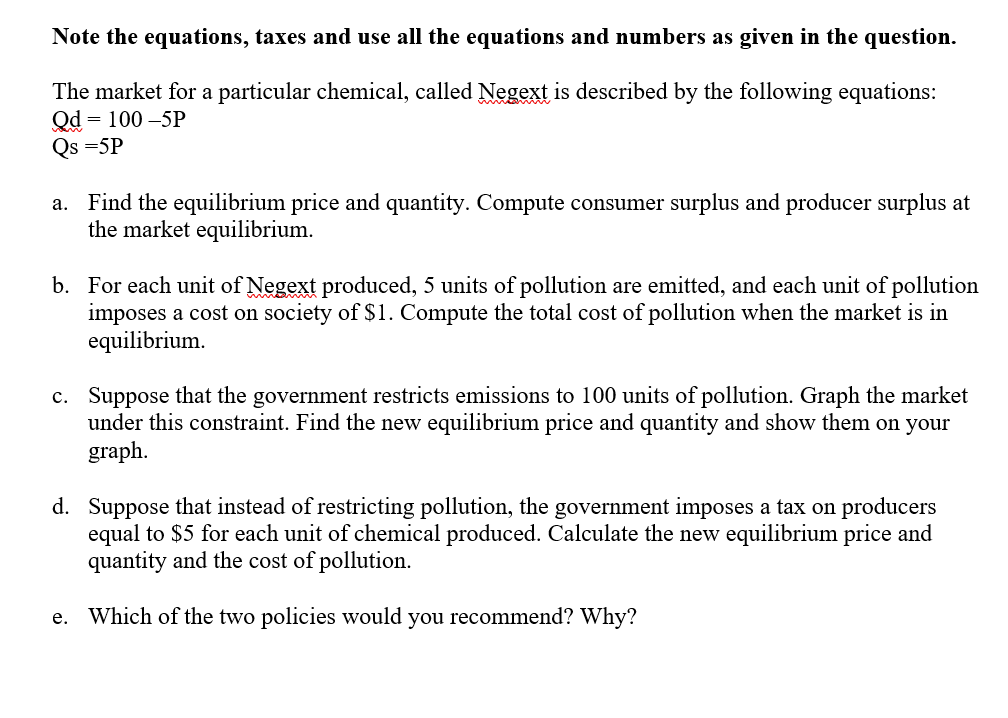Note the equations, taxes and use all the equations and numbers as given in the question. The market for a particular chemical, called Negext is described by the following equations: Qd = 100 –5P Qs =5P a. Find the equilibrium price and quantity. Compute consumer surplus and producer surplus a the market equilibrium. b. For each unit of Negext produced, 5 units of pollution are emitted, and each unit of pollutio imposes a cost on society of $1. Compute the total cost of pollution when the market is in equilibrium. c. Suppose that the government restricts emissions to 100 units of pollution. Graph the market under this constraint. Find the new equilibrium price and quantity and show them on your graph. d. Suppose that instead of restricting pollution, the government imposes a tax on producers equal to $5 for each unit of chemical produced. Calculate the new equilibrium price and quantity and the cost of pollution. e. Which of the two policies would you recommend? Why?
Note the equations, taxes and use all the equations and numbers as given in the question. The market for a particular chemical, called Negext is described by the following equations: Qd = 100 –5P Qs =5P a. Find the equilibrium price and quantity. Compute consumer surplus and producer surplus a the market equilibrium. b. For each unit of Negext produced, 5 units of pollution are emitted, and each unit of pollutio imposes a cost on society of $1. Compute the total cost of pollution when the market is in equilibrium. c. Suppose that the government restricts emissions to 100 units of pollution. Graph the market under this constraint. Find the new equilibrium price and quantity and show them on your graph. d. Suppose that instead of restricting pollution, the government imposes a tax on producers equal to $5 for each unit of chemical produced. Calculate the new equilibrium price and quantity and the cost of pollution. e. Which of the two policies would you recommend? Why?
Essentials of Economics (MindTap Course List)
8th Edition
ISBN:9781337091992
Author:N. Gregory Mankiw
Publisher:N. Gregory Mankiw
Chapter10: Externalities
Section: Chapter Questions
Problem 3PA: Greater consumption of alcohol leads to more motor vehicle accidents and, thus, imposes costs on...
Related questions
Question
Please solve the part d and e.

Transcribed Image Text:Note the equations, taxes and use all the equations and numbers as given in the question.
The market for a particular chemical, called Negext is described by the following equations:
Qd = 100 –5P
Qs =5P
Find the equilibrium price and quantity. Compute consumer surplus and producer surplus at
the market equilibrium.
а.
b. For each unit of Negext produced, 5 units of pollution are emitted, and each unit of pollution
imposes a cost on society of $1. Compute the total cost of pollution when the market is in
equilibrium.
c. Suppose that the government restricts emissions to 100 units of pollution. Graph the market
under this constraint. Find the new equilibrium price and quantity and show them on your
graph.
d. Suppose that instead of restricting pollution, the government imposes a tax on producers
equal to $5 for each unit of chemical produced. Calculate the new equilibrium price and
quantity and the cost of pollution.
e. Which of the two policies would you recommend? Why?
Expert Solution
This question has been solved!
Explore an expertly crafted, step-by-step solution for a thorough understanding of key concepts.
Step by step
Solved in 3 steps with 4 images

Knowledge Booster
Learn more about
Need a deep-dive on the concept behind this application? Look no further. Learn more about this topic, economics and related others by exploring similar questions and additional content below.Recommended textbooks for you

Essentials of Economics (MindTap Course List)
Economics
ISBN:
9781337091992
Author:
N. Gregory Mankiw
Publisher:
Cengage Learning

Exploring Economics
Economics
ISBN:
9781544336329
Author:
Robert L. Sexton
Publisher:
SAGE Publications, Inc

Microeconomics: Principles & Policy
Economics
ISBN:
9781337794992
Author:
William J. Baumol, Alan S. Blinder, John L. Solow
Publisher:
Cengage Learning

Essentials of Economics (MindTap Course List)
Economics
ISBN:
9781337091992
Author:
N. Gregory Mankiw
Publisher:
Cengage Learning

Exploring Economics
Economics
ISBN:
9781544336329
Author:
Robert L. Sexton
Publisher:
SAGE Publications, Inc

Microeconomics: Principles & Policy
Economics
ISBN:
9781337794992
Author:
William J. Baumol, Alan S. Blinder, John L. Solow
Publisher:
Cengage Learning